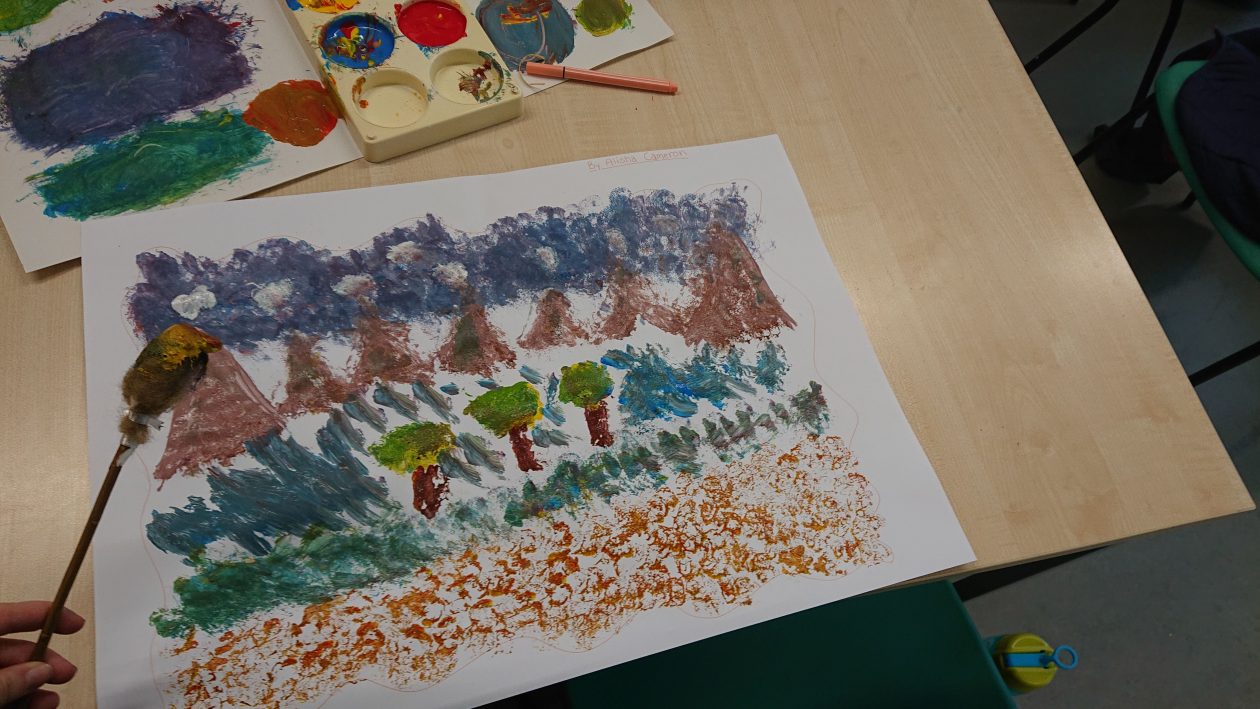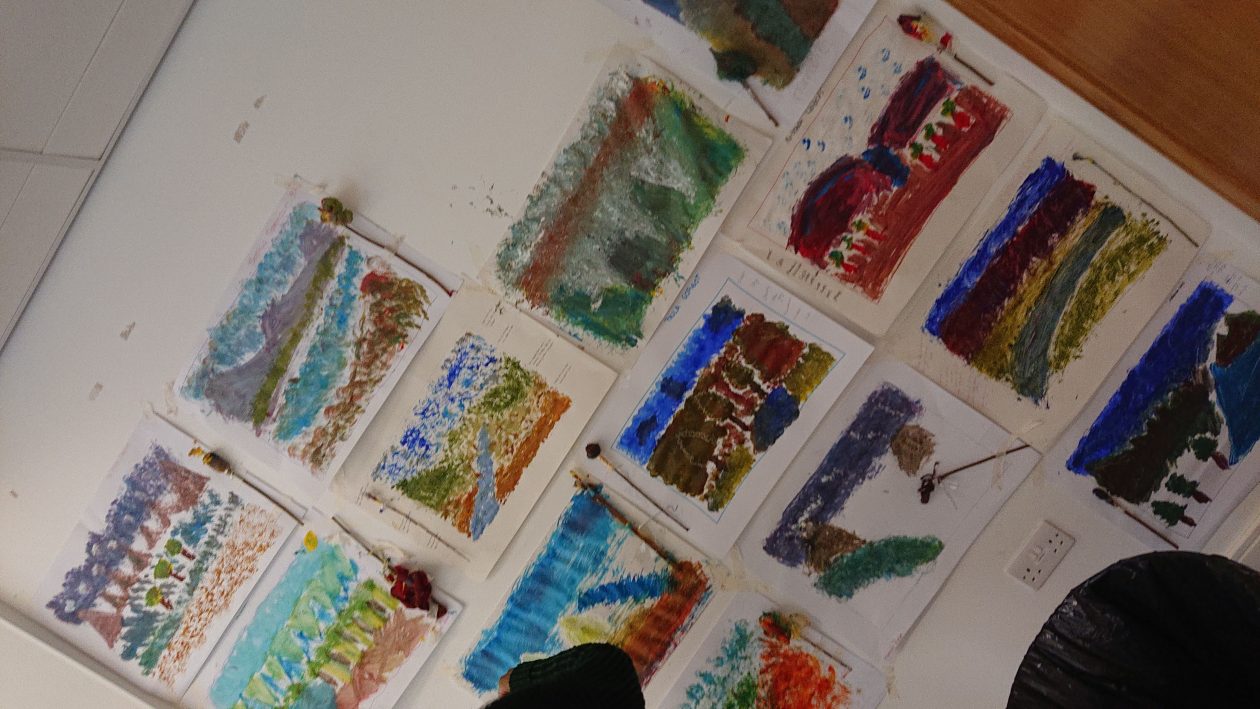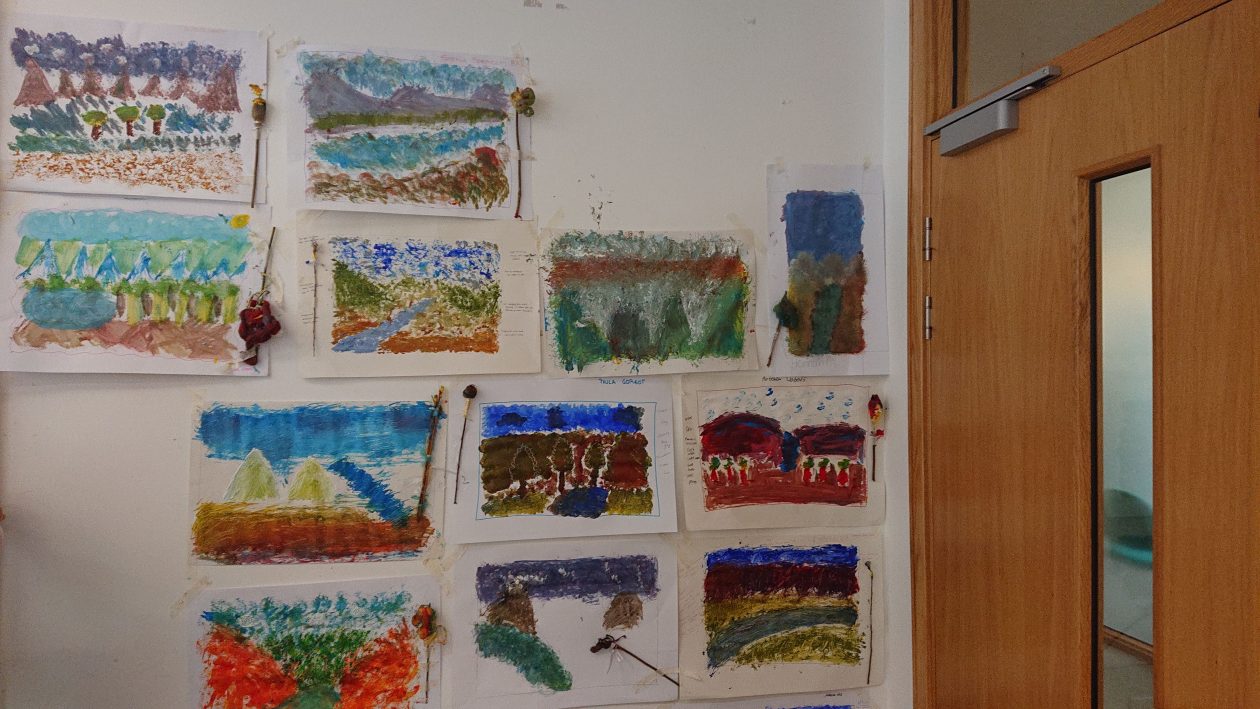Today was our last input in Integrated arts.
In music we explored teaching and playing the ukulele. We began by playing ‘My dog has fleas’, this is a short song which helps to tune your ukulele. Here is a short video of how to tune your ukulele:
(The ukulele teacher,2011)
We then spoke about the different parts of the ukulele. Here is a clip art of the different parts of it :
We then moved on to strumming the guitar. In order to do so you use your second fingers nail to strum down on the strings. Here is some songs you can play by strumming:


The first chord we learned to play was a C. This is what a C looks like on a ukulele:
 This was colour coded yellow on my ukulele to follow the figure notes method of learning.
This was colour coded yellow on my ukulele to follow the figure notes method of learning.
We then learned to play the F chord. This is what an F looks like on a ukulele:

This was colour coded red on my ukulele.
Here an some songs we learned to play using only the F and C chords:


We then moved on to learn the C7 chord. This is what the C7 chord looks like on the ukulele:

We then learned to play the Dm chord. This is what the Dm chord looks like on the ukulele:

Here is a song we learned to play with the C, C7 and Dm chords:

We then watched a video on the use of the same 4 chords being used to write a variety of pop songs, I found this very surprising :
(The Axis of Awesome, 2011)
We finished the session by using all the chords we had learned to play last Christmas. Here is a video of the lyrics, backing music and chords and a video of my peer playing last Christmas on the ukulele ;
(Best songs backing tracks, 2015)
Here are some other Christmas songs which you are able to play on the ukulele:
(The ukulele teacher, 2012)
The second half of the day took us to dance. For the past 4 weeks our cohort have been planning and practising a dance routine. Today we put the finishing touches to it and recorded our routine. This is a copy of the final full class performance :
https://vimeo.com/376244950
Curriculum for excellence states that all children should participate in performances and presentations. This should include opportunities to perform a dance to parents or in the community.
Here are some of the experiences and outcomes included in dance :
- I enjoy creating short dance sequences, using travel, turn, jump, gesture, pause and fall, within safe practice. EXA 1-08a
- I have created and taken part in dance from a range of styles and cultures. EXA 3-08a
- Inspired by a range of stimuli, I can express my ideas, thoughts and feelings through creative work in dance. EXA 0-09a / EXA 1-09a / EXA 2-09a
- I am becoming aware of different features of dance and can practise and perform steps, formations and short dance. EXA 1-10a
- I have opportunities to enjoy taking part in dance experiences. EXA 0-10a
- I can respond to the experience of dance by discussing my thoughts and feelings. I can give and accept constructive comment on my own and others’ work. EXA 0-11a / EXA 1-11a / EXA 2-11a / EXA 3-11a
(Scottish Government, 2008)
Over the past four weeks our class has covered every benchmark without even really realising it. It has been an extremely enjoyable experience, even for someone like me who does not dance. I look forward to teaching it in class.
Over the course of 12 weeks, it has become abundantly clear to me that exploration of dance, drama, music and art, have a major impact in preparing children to learn, achieve and succeed in all areas of life. I can now see it is crucial to embed these in our day to day teaching as we do with English and Maths.
References
Best Songs Backing Tracks, 2015. Last Christmas – Wham! Guitar Backing Track with scale, chords and lyrics. [Online] Available at : https://www.youtube.com/watch?v=GLhYC7F8uZw&feature=emb_title [Accessed 27/11/19]
Scottish Government, 2008. Curriculum for Excellence: Expressive Arts Experiences and Outcomes [online] Available at: https://education.gov.scot/Documents/expressive-arts-eo.pdf [Accessed 27/11/19].
The Axis of Awesome, 2011. 4 Chords | Music Videos | The Axis Of Awesome. [Online] Available at : https://www.youtube.com/watch?v=oOlDewpCfZQ [Accessed 27/11/19]
The ukulele teacher, 2011. How to tune a ukulele. [Online] Available at : https://www.youtube.com/watch?v=Dl7uzySXUSw [Accessed 27/11/19]
The ukulele teacher, 2012. How To Play Three Easy Christmas Songs on The Ukulele. [Online] Available at : https://www.youtube.com/watch?v=iQBOJRquyi0 [Accessed 27/11/19]
 The benefits of creative dance include :
The benefits of creative dance include :









 second song and so on. This was a very enjoyable task which helped to decrease the pressure on us to ‘choreograph’ and allowed us to do so without even realising it.
second song and so on. This was a very enjoyable task which helped to decrease the pressure on us to ‘choreograph’ and allowed us to do so without even realising it.

 class who have been taught to play through school. They came to visit us today to teach us to play string instruments, my primary 7 buddy taught me how to hold and play the cello, the different parts of the instruments I was playing and how to hold the bow correctly.
class who have been taught to play through school. They came to visit us today to teach us to play string instruments, my primary 7 buddy taught me how to hold and play the cello, the different parts of the instruments I was playing and how to hold the bow correctly. education system needs to begin to understand and celebrate the differences of our children, they are all magnificent in their own ways and we must develop their skills and passions.
education system needs to begin to understand and celebrate the differences of our children, they are all magnificent in their own ways and we must develop their skills and passions. has only ever been one school to have chosen to be assessed against the criteria of creativity. Why is this? Are schools simply choosing to ignore creativity?
has only ever been one school to have chosen to be assessed against the criteria of creativity. Why is this? Are schools simply choosing to ignore creativity? importance of having your own methodology, instead of just simply copying the work of others. The potential for creativity within a classroom is largely reliant on the relationships teachers build with the children, the style in which they teach, the level of enthusiasm they bring into the classroom, the interests and knowledge the teacher has and their
importance of having your own methodology, instead of just simply copying the work of others. The potential for creativity within a classroom is largely reliant on the relationships teachers build with the children, the style in which they teach, the level of enthusiasm they bring into the classroom, the interests and knowledge the teacher has and their  pedagogy. I was told on the first day of Integrated arts, that as a teacher, it is fundamental that we have a tolerance for both ambiguity and mess, both of these are at the framework for opening up opportunities for our class to be truly creative. In the words of Ken Robinson
pedagogy. I was told on the first day of Integrated arts, that as a teacher, it is fundamental that we have a tolerance for both ambiguity and mess, both of these are at the framework for opening up opportunities for our class to be truly creative. In the words of Ken Robinson the exact does not promote creativity, in fact far from it. Doing tasks such as this streamline the outcome and therefore hold back the children from adding any real individual artist flare to their work. Ken Robinsons ted talk explores this concept of streamlining results, and he shares the concept that educational systems see mistakes as the worst thing to possibly happen (Ken Robinson 2007). In doing so they are educating children out of their creative capacities and steering them towards a life time of refusing to stand out in fear of being wrong.
the exact does not promote creativity, in fact far from it. Doing tasks such as this streamline the outcome and therefore hold back the children from adding any real individual artist flare to their work. Ken Robinsons ted talk explores this concept of streamlining results, and he shares the concept that educational systems see mistakes as the worst thing to possibly happen (Ken Robinson 2007). In doing so they are educating children out of their creative capacities and steering them towards a life time of refusing to stand out in fear of being wrong. subjects at order of importance. The subjects deemed most important are those which are useful at work such as maths and English, with the arts being placed at the bottom and children in later education being steered away from following a career in the arts because ‘you simply wont ever get a job in the arts’.
subjects at order of importance. The subjects deemed most important are those which are useful at work such as maths and English, with the arts being placed at the bottom and children in later education being steered away from following a career in the arts because ‘you simply wont ever get a job in the arts’.
 place. I want the children in my care to explore their full creative potential and to never shy away from being wrong. Our education system is currently streamlining our children’s minds in the way that we have mined the planet for a single material. This will fail us in the future, and I want to enforce change.
place. I want the children in my care to explore their full creative potential and to never shy away from being wrong. Our education system is currently streamlining our children’s minds in the way that we have mined the planet for a single material. This will fail us in the future, and I want to enforce change. The focus in Norwegian schools is outdoor learning and is a far cry from our focus on Maths and English. I would love to visit Norway to see their teaching in action as I feel I could learn a lot. I would have liked to have found out more about Norway and the individuals who are visiting, however, they were in the other section and I was unable to spend any time with them.
The focus in Norwegian schools is outdoor learning and is a far cry from our focus on Maths and English. I would love to visit Norway to see their teaching in action as I feel I could learn a lot. I would have liked to have found out more about Norway and the individuals who are visiting, however, they were in the other section and I was unable to spend any time with them. Garageband :
Garageband :





 piece of music.
piece of music.












 more likely to sustain mental control during memory and recall tasks, this is likely due to their longterm music training . (Berti et al., 2006).
more likely to sustain mental control during memory and recall tasks, this is likely due to their longterm music training . (Berti et al., 2006). around the book giraffes can’t dance. Giraffes can’t dance is a booked aimed at children from 3 – 6 years old, which follows Gerald a friendly giraffe which unfortunately cannot dance. The book allows the children to go along with Gerald on his journey to learn how to dance at the party with his animal friends.
around the book giraffes can’t dance. Giraffes can’t dance is a booked aimed at children from 3 – 6 years old, which follows Gerald a friendly giraffe which unfortunately cannot dance. The book allows the children to go along with Gerald on his journey to learn how to dance at the party with his animal friends.






